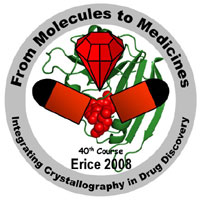It is primarily intended to educate the upcoming generation with
experts drawn worldwide, in an intensive, hand-on forum not available
at any other meeting, and in particular, unavailable to these students
in any other way.
Global disease is perhaps the greatest threat to mankind. There are
three primary tools at our disposal to counter this threat, vaccines,
drugs and diagnostic tests. Protein crystallography plays a major
role in all of these, from its contribution to the explanation of
fundamental biological processes to the application of structure-based
drug design.
Scientifically, there is no better aid to the understanding of biological
processes than to be able to visualize the exact position of every atom
in a biologically active molecule. It is therefore not surprising that
protein crystallography is such a fundamental part of the modern drug
discovery process; both in increasing our understanding of disease processes
and in the direct, structure-based design of drugs. Parallel to the
developments in structural biology, great strides have been made towards
targeted medicines. The discipline of bioinformatics is maturing towards
‘systems biology', i.e. a complete elucidation of the biology of an
organism; this has been massively aided by the completion of the sequencing
of the human genome. Highly targeted medicines, specifically tailored
to small groups of patients, are a reality that is already with us,
one that has a fundamental dependence on understanding biology at a
molecular level. Protein crystallography not only impacts on society
via health, but also
via economics. This is particularly
so in Europe, which has a rich history in medicines research, from the
pioneering studies at the turn of the last century through to the establishment
of the pharmaceutical giants and biotechnology industry of today, a
key part of Europe's economic strength. Competition in this industrial
field requires young European scientists to be trained to be able to
exploit the techniques in this multidisciplinary area.


